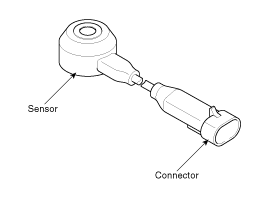 Hyundai Veloster: Knock Sensor (KS). Description and Operation
Hyundai Veloster 2011-2017 Service Manual / Fuel System / Engine Control System / Knock Sensor (KS). Description and Operation
Hyundai Veloster: Knock Sensor (KS). Description and Operation
Hyundai Veloster 2011-2017 Service Manual / Fuel System / Engine Control System / Knock Sensor (KS). Description and Operation
Hyundai Veloster 2011-2017 Service Manual / Fuel System / Engine Control System / Knock Sensor (KS). Description and Operation
Description
Knocking is a phenomenon characterized by undesirable vibration and noise
and can cause engine damage. Knock Sensor (KS) is installed on the cylinder
block and senses engine knocking.
When knocking occurs, the vibration from the cylinder block is applied
as pressure to the piezoelectric element. When a knock occurs, the sensor produces
voltage signal. The ECM retards the ignition timing when knocking occurs. If
the knocking disappears after retarding the ignition timing, the ECM will advance
the ignition timing. This sequential control can improve engine power, torque
and fuel economy.

 Camshaft Position Sensor (CMPS). Repair procedures
Camshaft Position Sensor (CMPS). Repair procedures
Inspection
1.
Check the signal waveform of the CMPS and CKPS using the GDS.
Specification:
Refer to “Wave Form”
...
 Knock Sensor (KS). Specifications
Knock Sensor (KS). Specifications
Specification
Item
Specification
Capacitance (pF)
950 ~ 1,350
Resistance (MΩ)
4.87
...
See also:
Clutch Master Cylinder. Components and Components Location
Components
1. Reverse hose
2. Master cylinder
3. Ignition lock switch
4. Clutch switch
5. Clutch arm assembly
6. Pedal pad
...
Consumer information
This consumer information has been prepared in accordance with regulations issued
by the National Highway Traffic Safety Administration of the U.S. Department of
Transportation. Your Hyundai deale ...
Description and Operation
Description
The charging system includes a battery, an alternator with a built-in
regulator, and the charging indicator light and wire.
The Alternator has built-in diodes, each rectifying A ...
Categories
- Hyundai Veloster Manuals Home
- Hyundai Veloster 2010-2017 Owner's Manual
- Hyundai Veloster 2010-2017 Service Manual
© 2011-2026 Copyright www.hvmanual.com
